Substituting Far-Red for Traditionally Defined Photosynthetic Photons Results in Equal Canopy Quantum Yield for CO2 Fixation and Increased Photon Capture During Long-Term Studies: Implications for Re-Defining PAR
- PMID: 33014004
- PMCID: PMC7516038
- DOI: 10.3389/fpls.2020.581156
Substituting Far-Red for Traditionally Defined Photosynthetic Photons Results in Equal Canopy Quantum Yield for CO2 Fixation and Increased Photon Capture During Long-Term Studies: Implications for Re-Defining PAR
Abstract
Far-red photons regulate shade avoidance responses and can have powerful effects on plant morphology and radiation capture. Recent studies have shown that far-red photons (700 to 750 nm) efficiently drive photosynthesis when added to traditionally defined photosynthetic photons (400-700 nm). But the long-term effects of far-red photons on canopy quantum yield have not yet been determined. We grew lettuce in a four-chamber, steady-state canopy gas-exchange system to separately quantify canopy photon capture, quantum yield for CO2 fixation, and carbon use efficiency. These measurements facilitate a mechanistic understanding of the effect of far-red photons on the components of plant growth. Day-time photosynthesis and night-time respiration of lettuce canopies were continuously monitored from seedling to harvest in five replicate studies. Plants were grown under a background of either red/blue or white light, each background with or without 15% (50 μmol m-2 s-1) of far-red photons substituting for photons between 400 and 700 nm. All four treatments contained 31.5% blue photons, and an equal total photon flux from 400 to 750 nm of 350 μmol m-2 s-1. Both treatments with far-red photons had higher canopy photon capture, increased daily carbon gain (net photosynthesis minus respiration at night), and 29 to 31% more biomass than control treatments. Canopy quantum yield was similar among treatments (0.057 ± 0.002 mol of CO2 fixed in gross photosynthesis per mole of absorbed photons integrated over 400 to 750 nm). Carbon use efficiency (daily carbon gain/gross photosynthesis) was also similar for mature plants (0.61 ± 0.02). Photosynthesis increased linearly with increasing photon capture and had a common slope among all four treatments, which demonstrates that the faster growth with far-red photon substitution was caused by enhanced photon capture through increased leaf expansion. The equivalent canopy quantum yield among treatments indicates that the absorbed far-red photons were equally efficient for photosynthesis when acting synergistically with the 400-700 nm photons.
Keywords: canopy photosynthesis; carbon use efficiency; far-red photons; phytochrome equilibrium; quantum yield; radiation capture.
Copyright © 2020 Zhen and Bugbee.
Figures
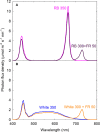
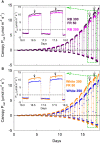

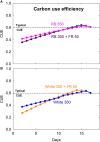


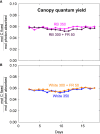
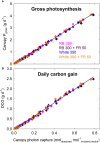
Similar articles
-
Orange photons (623 nm) resulted in similar or greater lettuce growth than red photons (660 nm): comparative effects on morphology, photon capture, and photosynthesis.Front Plant Sci. 2025 Jul 30;16:1653524. doi: 10.3389/fpls.2025.1653524. eCollection 2025. Front Plant Sci. 2025. PMID: 40810025 Free PMC article.
-
Far-red photons have equivalent efficiency to traditional photosynthetic photons: Implications for redefining photosynthetically active radiation.Plant Cell Environ. 2020 May;43(5):1259-1272. doi: 10.1111/pce.13730. Epub 2020 Feb 12. Plant Cell Environ. 2020. PMID: 31990071
-
Adaptation to high CO2 concentration in an optimal environment: radiation capture, canopy quantum yield and carbon use efficiency.Plant Cell Environ. 1998;21:315-24. doi: 10.1046/j.1365-3040.1998.00284.x. Plant Cell Environ. 1998. PMID: 11543216
-
Achievable productivities of certain CAM plants: basis for high values compared with C3 and C4 plants.New Phytol. 1991 Oct;119(2):183-205. doi: 10.1111/j.1469-8137.1991.tb01022.x. New Phytol. 1991. PMID: 33874131 Review.
-
THE THERMODYNAMIC EFFICIENCY (QUANTUM DEMAND) AND DYNAMICS OF PHOTOSYNTHETIC GROWTH.New Phytol. 1986 Jan;102(1):3-37. doi: 10.1111/j.1469-8137.1986.tb00794.x. New Phytol. 1986. PMID: 33873885 Review.
Cited by
-
Growth, Biomass Partitioning, and Photosynthetic Performance of Chrysanthemum Cuttings in Response to Different Light Spectra.Plants (Basel). 2022 Dec 1;11(23):3337. doi: 10.3390/plants11233337. Plants (Basel). 2022. PMID: 36501376 Free PMC article.
-
Far-red light effects on plant photosynthesis: from short-term enhancements to long-term effects of artificial solar light.Ann Bot. 2025 Feb 19;135(3):589-602. doi: 10.1093/aob/mcae104. Ann Bot. 2025. PMID: 38946023 Free PMC article.
-
Far-red light modulates grapevine growth by increasing leaf photosynthesis efficiency and triggering organ-specific transcriptome remodelling : Author.BMC Plant Biol. 2024 Mar 15;24(1):189. doi: 10.1186/s12870-024-04870-7. BMC Plant Biol. 2024. PMID: 38486149 Free PMC article.
-
Photosynthesis in rice is increased by CRISPR/Cas9-mediated transformation of two truncated light-harvesting antenna.Front Plant Sci. 2023 Jan 19;14:1050483. doi: 10.3389/fpls.2023.1050483. eCollection 2023. Front Plant Sci. 2023. PMID: 36743495 Free PMC article.
-
Plant competition cues activate a singlet oxygen signaling pathway in Arabidopsis thaliana.Front Plant Sci. 2024 Aug 20;15:964476. doi: 10.3389/fpls.2024.964476. eCollection 2024. Front Plant Sci. 2024. PMID: 39228834 Free PMC article.
References
-
- Adams C., Jacobson A., Bugbee B. (2014). Ceramic aggregate sorption and desorption chemistry: implications for use as a component of soilless media. J. Plant Nutr. 37, 1345–1357. 10.1080/01904167.2013.837921 - DOI
-
- Amthor J. S. (1989). Respiration and crop productivity (New York, USA: Springer-Verlag; ).
-
- Amthor J. S. (2000). The McCree–de Wit–Penning de Vries–Thornley respiration paradigms: 30 years later. Ann. Bot. 86, 1–20. 10.1006/anbo.2000.1175 - DOI
-
- Anderson J. M., Chow W. S., Goodchild D. J. (1988). Thylakoid membrane organisation in sun/shade acclimation. Funct. Plant Biol. 15, 11–26. 10.1071/PP9880011 - DOI
LinkOut - more resources
Full Text Sources

